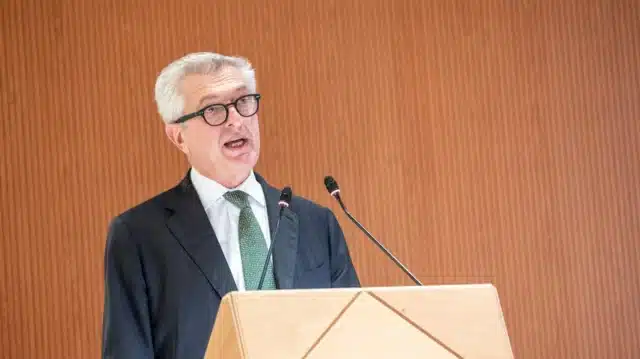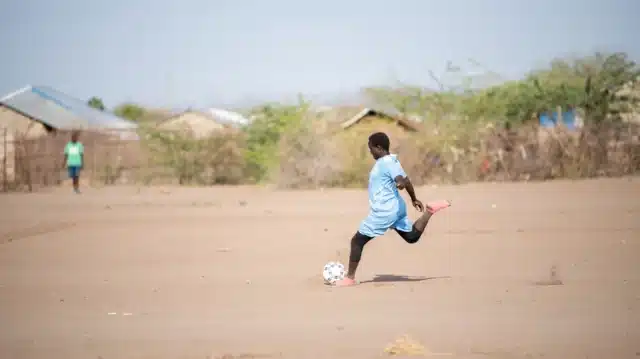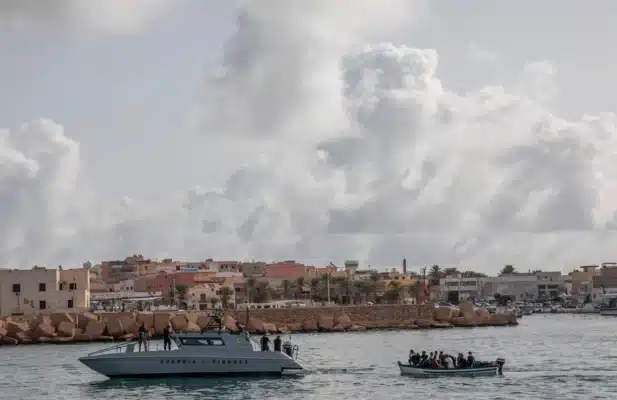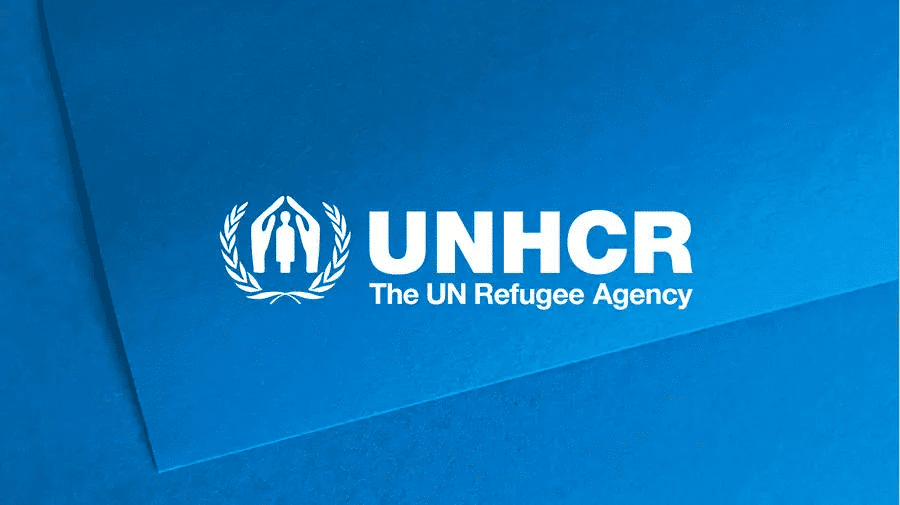
© UNHCR
Mister Chair, Excellencies, ladies and gentlemen, colleagues,
The High Commissioner’s Note on International Protection this year takes its inspiration from the Universal Declaration of Human Rights, agreed 75 years ago. For it was the Declaration that first affirmed that everyone has the right to seek and enjoy asylum. Three years later, the 1951 Refugee Convention gave concrete legal force to this right, adding the binding standards for protection and the fundamental obligation of sovereign governments not to return someone to persecution.
Protection lies at the heart of all UNHCR’s work. Whether here in HQ or in the field. Protection is a big word. What do we mean by it? We mean supporting States in safeguarding access to asylum and the prohibition of refoulement, we mean registration, legal aid and civil documentation, access to social services and decent work, education and support for children, cash distributions, and psycho-social support for survivors of gender-based violence, and support for especially vulnerable people, including the elderly or disabled.
The High Commissioner’s Note sets out some encouraging progress in protection, observing that many countries have kept their borders open to asylum seekers and have generously offered livelihood opportunities, including refugees in national education and health services, despite the burdens this invariably poses on society.
But the Note also observes that some States deny territorial access to asylum seekers, pushing them back at land and sea borders and risking refoulement, and shifting the responsibility to other, usually poor, or lower income countries.
The High Commissioner has described the dire plight of millions of displaced people, whether within their own countries or across boundaries, and the funding gulf that grows, impeding effective international protection.
I will focus on the future. On UNHCR’s efforts to find practical solutions:
- through international finance and development partners and the private sector to promote self-sufficiency;
- developing a “whole of journey” approach; and
- on the long-term strategies of the Global Compact on Refugees.
I would like to begin with the words of the UN Secretary General, in his recent speech to the General Assembly.
“When refugees, migrants and minorities are routinely demonized and hounded.
When declaring your gender identity or simply who you love can lead to imprisonment or even execution.
When speaking out can lead to perilous consequences.
Human rights – political, civil, economic, social, and cultural – are the key to solving many of the world’s interlinked problems…”
Many of the root causes of forced displacement are to be found in breaches of the human rights law that the Universal Declaration was designed to protect: the rights to equality, to life, liberty, and security, to protection from discrimination and arbitrary arrest and detention, access to education, decent work, freedom of movement, and to nationality.
So many of you have mentioned the 110 million displaced globally. We need to take stock of global trends. Displacement today is characterized by the sheer scale of people displaced by protracted wars and conflicts, by political instability prompting coups d’états, by competition for scarce water and food resources, and by the deadly impact of climate change, all exacerbated by inflation, inequality, environmental disasters, such as earthquakes, volcanic eruptions, cyclones, leading to yet more displacements.
In complex situations of internal displacement, the UN Refugee Agency focuses on ensuring access to protection services, particularly in remote and hard-to-reach areas, and UNHCR leads the Global Protection Cluster, which this year has prioritised “access that protects”.
However, traditional long-term solutions are hard to find. Many of you have spoken about the need for voluntary returns to the country of origin, for it is true, most refugees want to go home. But with continued insecurity and lack of funds this is sadly often not possible.
We have seen the resurgence of resettlement places since COVID-19 and will be submitting 117,000 places for the most vulnerable for resettlement this year, a remarkable resurgence of the programme. Regular pathways to solutions, such as education opportunities, labour mobility, community sponsorship, and access to family reunification are increasing. Sadly, these opportunities, while vital, are available to so very few. Millions remain without hope.
The reality for most displaced people lies in non-discriminatory inclusion within their host communities whether in their own country or across borders. The consequence is, as so many of you have mentioned, that at least 75 per cent of the burden of hosting refugees lies with low to middle income countries, especially to countries neighbouring areas of conflict. It is possibly no accident of geography that many of these countries are also among the most vulnerable to climate impacts; most Afghans are hosted by Pakistan and Iran, Somalis by Kenya, Ethiopia, Djibouti, Uganda and Yemen, Syrians hosted by Türkiye, Jordan, Lebanon, and Egypt and Rohingya hosted by Bangladesh. Addressing this unequal burden is the primary challenge for the international community.
We need to think afresh about protection and solutions; to be bold in stimulating multistakeholder initiatives, and creative in attracting the funding to address root causes and to build self-sufficiency.
We also need to listen to the concerns of host governments and their communities as they welcome refugees and address internal displacement.
We need to recognize that, as forced displacement rises, so too have perceptions that the asylum system is “broken”; that it is no longer capable of providing adequate protection; that legal reform is needed.
UNHCR’s response to such concerns is clear. The Refugee Convention has endured for over 72 years. It continues to save millions of lives and is more vital and effective than ever before.
There are, nonetheless, justifiable, understandable concerns about the asylum system; legal processes for refugee status determination are often slow and burdensome, with lengthy appeal processes, leading to significant backlogs; refugees wait for years without the right to work, relying on humanitarian aid and social assistance, unable to use their skills to contribute to their host communities; many movements are mixed groups of refugees and migrants raising the need for speedy determination of whether they have international protection needs; returning home to their countries of origin those not in need of international protection is often close to impossible in the absence of agreements with those states of origin and resources so badly needed for successful reintegration.
Some governments have responded to these challenges by adopting extreme deterrent measures, denying entry at their borders, pushing back at frontiers, refusing to rescue those in distress at sea – even denying disembarkation to those who have been rescued. Some have passed laws imposing mandatory detention on irregular entry, even for children, externalizing or shifting responsibilities to other countries in clear breach of international law, and conducting forced returns to third countries without safeguards, risking refoulement.
The international regime for refugee protection is under serious threat.
But I suggest that the gravest challenge lies not in the Refugee Convention itself, but in the failure by some States to implement it and to adapt their asylum systems to these new realities. Indeed, a few governments have legislated to halt access to their asylum systems, eliminating one of the most effective solutions, a fair and fast determination process of refugee status and a safe return of those not in need of international protection.
Recognizing that business as usual is no longer an option, UNHCR stands ready to support States to modernize their systems and we call on States to share their expertise by pledging to support other States to reinforce their capacities through the Asylum Capacity Support Group at the upcoming Global Refugee Forum.
But over the last 72 years, the Refugee Convention has shown an ability to adapt flexibly to contemporary protection risks. In response to the COVID-19 pandemic, many governments found creative ways to both protect public health and to ensure access to asylum through digital technologies; refugee protection has been extended by tribunals and by countries to victims of violence and intimidation by criminal gangs, and to women and girls, victims of female genital mutilation.
A new challenge for the Refugee Convention – and for us all – arises when people flee across national boundaries from the impacts of climate change. International refugee law in response to the climate crises is evolving. Where climate change leads to conflict and flight, refugee law will frequently apply. In Northern Cameroon and Somalia, for example, droughts and diminishing water resources have led to intercommunal violence and flight to neighbouring countries, including Chad and Ethiopia.
Not all those displaced in the context of climate change will be refugees – today, most of those suffering from extreme drought, floods, or wild-fires, will be displaced within their own countries – but all are entitled to their human rights. In responding to the multiple effects of climate change UNHCR advocates for the inclusion of refugees in climate action plans and scaling up accessible financing for host countriesLink is external.
This then is the highly volatile environment in which UNHCR seeks to provide protection.
What are the practical and sustainable solutions?
The overarching strategy, indeed, UNHCR’s guiding star, lies in the:
Global Compact on Refugees agreed in 2018 and supported by 181 States in the General Assembly.
It has been heartening to hear the overwhelming support that ExCom members and civil society have given to the Compact. The Compact adopts a bold, even revolutionary response, with two key ideas: one, to share equitably the burden and responsibilities for refugees; the other, whole of society contribution to that equitable sharing. This engages not only sovereign governments, but also local communities, faith groups, NGOs, refugee-led organizations, cities, mayors and local government, sports groups, universities and scholars, parliamentarians, the private sector and development banks.
Many initiatives have been adopted in the spirit of the compact.
Development and Investment partnerships
One of the most effective partnerships over the last few years has been UNHCR’s catalytic, non-transactional partnership with development banks and international financial institutions.
As the High Commissioner has mentioned, development assistance of over 11 billion USD has been made available 2020-2021 by bilateral donors and multilateral banks, directly enabling the inclusion of refugees in national social systems.
- A particular example is the exemplary partnership with the World Bank and the International Development Association’s Window for Host Communities and Refugees which has made $3.2 billion investments in 16 low-income countries hosting refugees. UNHCR through our country offices and our Division of International Protection provides assessments of the legal and policy environment for refugees and human rights, facilitating the release of funds. The World Bank has increased its budget of $2.4 billion for 17 low-income eligible countries over the next 3 years giving access to food, housing, and education to refugee households.
- Another example is the Ethiopia Economic Opportunities Programme providing economic opportunities for Ethiopians and refugees accelerating refugee reforms, granting refugees the right to work and own property, expanding asylum protection, allowing more freedom of movement and access to the documentation that refugees so badly need, education, health and other national services.
- We have heard about the Shirika plan in Kenya, the subject of a side event, an exciting example of investment by development actors and the private sector to support the government-led transition from camps to settlements with economic opportunities for both the host community and refugees. This is global best practice and a model we believe for other long term refugee camps and initiatives in other countries.
A second initiative, developed within the spirit of the Global Compact, is a “whole of journey” or “whole of route” approach to mixed and onward movements, or as the HC has called for, a “panoramic” view.
Exact numbers are hard to confirm, but we know that by this month, over 2,517 people are dead or missing this year alone in the Central Mediterranean. The numbers are likely to be very high in other parts of the world. We have all seen pictures of unsafe, overloaded dinghies arriving in Lampedusa from Tunisia or Libya, and reports of the loss of hundreds of lives off the coast of Pylos in Greece. State responses to these mixed refugee and migrant movements have focussed on unilateral deterrent solutions and some bilateral agreements.
But such limited approaches are not enough. A comprehensive strategy is needed for the entire well-trodden routes from the country of origin, through transit countries, to countries of destination. Whether those risking dangerous journeys are refugees escaping conflict or migrants in the search of opportunities to build their lives, they often have similar protection needs and the protection of their rights is an imperative. Along the route they lack food, heath care and documentation and need accurate information about regular pathways. They are vulnerable to arbitrary arrest and detention, to human traffickers, and to sexual exploitation.
In response, UNHCR is working closely with IOM to develop an approach that offers protection and solutions at critical points along mixed movement routes using a “whole of society” approach, working with local communities, mayors and cities, faith groups and the private sector along with other UN agencies and NGOs.
A “whole of journey” approach for protection will:
- Support fair and fast assessment of international protection needs.
- It will explore safe and regular options in third countries: labour mobility, education and scholarships, family reunion or community sponsorship programmes.
- And it will ensure benefits and support for local communities by combining humanitarian aid with development and investment.
There are no quick fixes for the challenges posed by mixed movements. But the “whole of journey” approach is already attracting attention of policy advisors, politicians, civil society, and the media.
Some initiatives are proving the concept, including the recent creation of Safe Mobility Offices in Colombia, Guatemala, and Costa Rica in line with the Los Angeles Declaration. Through these offices, IOM and UNHCR are referring people to the US Refugee Admissions Program or to regular pathways such as humanitarian parole, family reunion, and labour visas. Spain and Canada, I am pleased to say, have now joined this initiative with the United States.
Practical support is also available through the “blue bus” initiative in Guatemala that I saw when on a visit there. It helps survivors report gender-based violence in rural areas and provide support along refugee and migration routes.
Similarly, although in a refugee and not a mixed-movements context, the 36 Blue Dot centers established with UNICEF in Europe in response to the war in Ukraine have delivered services and safe referrals at border crossings, railway stations, cities, local communities; you can see that blue dot from many, many locations. Services include psychosocial support, information about employment opportunities, child protection, safe accommodation, and registration for social services.
A vital element of the “whole of journey” approach is to strengthen national asylum systems. Our Regional Bureau in West Central Africa has, for example, provided guidance on differentiated procedures in the Central Sahel and in West African coastal countries, working with national asylum authorities to respond to the current crisis in the region.
We believe that this whole of journey approach offers a practical alternative to deterrence tactics that are harmful to refugees and largely unsuccessful. But we must be crystal clear. A joined up, whole of society engagement in protection along the journey includes – and indeed is founded upon – the right to seek asylum at territorial borders. Governments should not “cherry pick” the elements they favour.
Global Refugee Forum
With these, I hope, positive roadways to solutions, I would like to return to the Global Compact on Refugees and its key global mechanism for implementation, the Global Refugee Forum.
We are in the home stretch to the second Forum in December at which, 4 years after the first Forum in 2019, we will assess implementation of the Compact. You will all remember that over 1,400 pledges were made in 2019, including financial commitments and pledges to strengthen asylum systems, end statelessness and include refugee in education, health, and livelihoods.
We have learned a lot over the last 4 years. The pledges have been crucial in demonstrating good faith and goodwill but they must be implemented. Often, while the will is there, funding is not.
One of the key elements of the Compact is the agreement to measure concrete impacts with data and hard evidence.
The next Indicator Report will be available on 17 November. Without giving too much away, I can say it shows that sharing of responsibility for refugees has made sustained progress in some key areas, despite the damaging headwinds of COVID-19, the war in Ukraine, civil conflicts, political instability, food insecurity and natural disasters, but much more needs to be done to achieve truly equitable burden and responsibility sharing and lasting solutions. We were not going to achieve all the ambitions of the Compact within 4 years, but we are on the road to doing so, and we can sustain this momentum through your steadfast support and through multistakeholder commitments at the next forum.
Chad provides a model of good practices. It is one of the least developed countries in the world with around half of the population living below the poverty line. Yet it hosts more than one million people forcibly displaced, including recent arrivals fleeing the conflict in Sudan. Chad has implemented its pledges to include refugees and granted them freedom of movement and access to national health, education, and justice systems. Importantly, more than 200,000 refugees have now received arable land to farm to achieve dignity and self-reliance.
Support Platforms
Progress under the Compact has also been promoted by the Support Platforms that provide a forum to convene key actors and to coordinate protection and solutions.
On our mission to Afghanistan a few months ago I saw the impact of the Support Platform for Afghan Refugees in enabling the building of community centres, schools, clinics and houses, supporting the resilience of those women and girls, despite their exclusion from work, education, and public places.
Similarly, we are very excited by the work done through the MIRPS Support Platform enabling technical capacity at the local level and the IGAD Support Platform is garnering support for pledges on climate adaptation and durable solutions.
Meaningful refugee participation
The Global Compact on Refugees recognizes that international protection is most effective when refugees engage meaningfully with all policies, decisions and programs that affect their lives. They are agents of change and should have a seat at the table. As one refugee said to me, they want to be involved “from zero to one hundred percent”. It is both a moral imperative and the smart thing to do. I thank the US, Canada and Germany for ensuring refugee representation in their delegations.
UNHCR has redoubled its efforts to ensure refugee participation at the Forum and we expect 300 refugees to attend the meeting, including 70 selected refugee experts and some children. With this significantly increased role for refugees, we expect to see a lively, dynamic, creative forum in December, informed by the lived experiences of asylum seekers and refugees.
Inclusion in national social services has been stressed by almost all of you over these three days. It has been my honour at UNHCR to serve as a disability champion for inclusion under the Age, Gender and Diversity policy.
I was particularly fortunate to represent UNHCR at this year’s Special Olympics World Games in Berlin for people with intellectual disabilities. This proved a powerful example of a point that has been made, the transformative power of sport to ensure inclusion for all, perhaps one day at the Olympics but certainly in local sports activities, including for those forcibly displaced with disabilities.
Well, I am often asked what UNHCR expects from the Forum. What does success look like?
We hope:
- To demonstrate measurable protection and solutions outcomes;
- To transcend the business-as-usual with new, innovative and smart initiatives;
- To elevate our ambitions with multistakeholder mega pledges that are genuinely transformational.
Success also means a global political commitment to leverage the mega pledges over the next four years to translate the Compact into impactful results.
An end to statelessness.
Before I close, I wish to recognise the significant progress in addressing statelessness since the start of the #IBelong campaign. These last few years have seen genuine improvements. Many delegations this week have told us of their measures to grant nationality to stateless people within their countries and to eradicate statelessness. We applaud the ratification of the Statelessness Conventions by the Republic of the Congo, the reforms by Kenya and Turkmenistan and welcome the commitments by São Tomé and Príncipe.
Taking over from the #IBelong campaign at the end of next year is the new Global Alliance. To widen partnerships and to end statelessness we will launch a new Solution Seeker programme at the GRF.
Eradicating statelessness is a realizable goal.
Hope Away from Home
So it is with these ambitions in mind that UNHCR launched its global campaign Hope Away from Home, calling for greater solidarity and strengthening commitments for the right to seek asylum.
The Global Compact on Refugees provides a powerful antidote to politicization of refugee movements and means to address their need for international protection.
Together, with Member States, refugees, international financial institutions, development actors, academia, the private sector, and civil society, we must stand up for those forcibly displaced and speak up against anti-refugee rhetoric.
May I conclude by thanking you, our member states of ExCom and civil society, for your steadfast support for the principle of burden and responsibility sharing.
This is my fifth and last ExCom and my term comes to an end after the Forum. I would like to thank the HC for his very kind words and say what a privilege it has been to work on protection with this amazing team at HQ, Kelly as Deputy and Raouf as Assistant High Commissioner for Operations, may I join all of you in commending all of our colleagues, it is quite extraordinary how hard they work, whether it is in the field or at HQ. I very much look forward to working with you in these remaining weeks preparing for the Global Refugee Forum in December.
Thank you.
